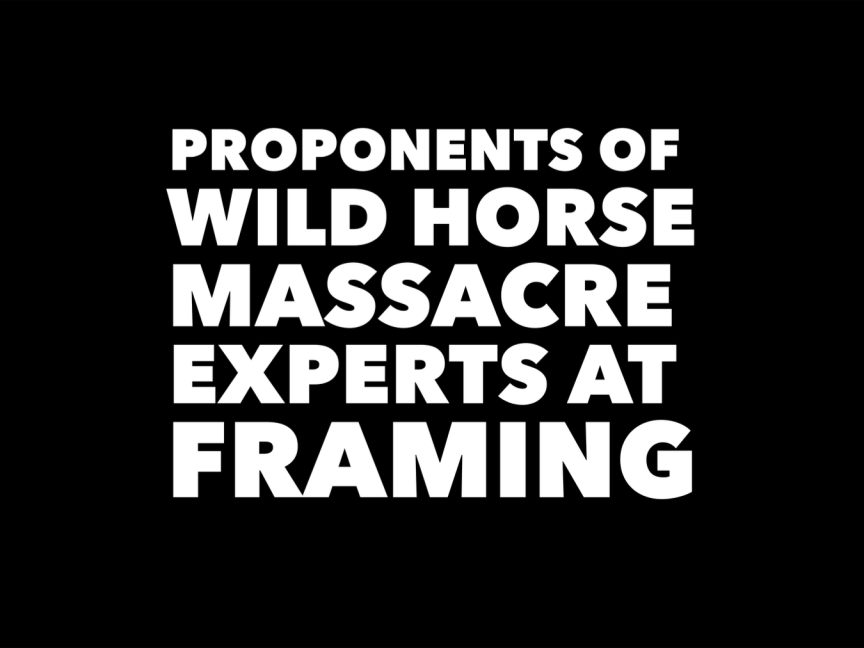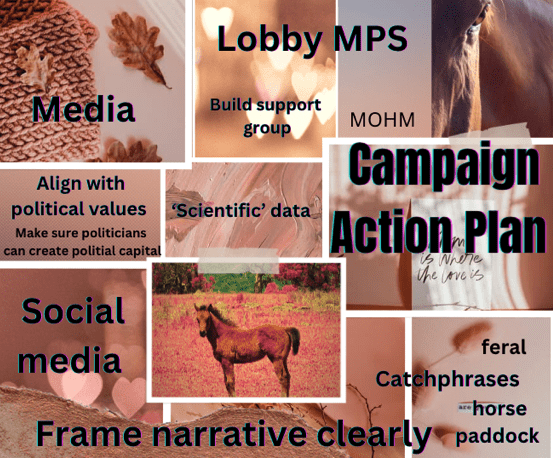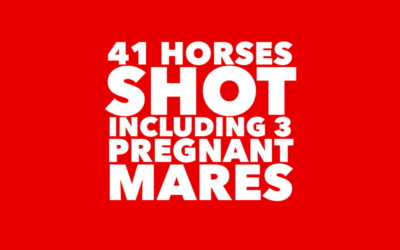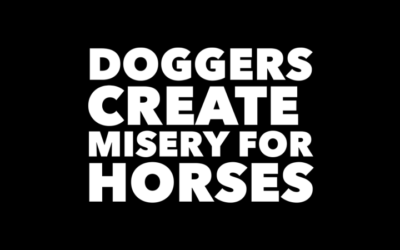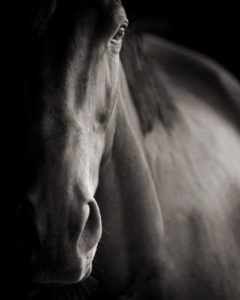ADVOCATES FOR BRUMBIES TAKE NOTE
The barbaric, inhumane slaughtering of Brumbies in Australia has been cleverly ‘framed’ by those supporting aerial culling and ground shooting.
There are many strategies at work in the success of the proponents.
Supporters of aerial culling of wild horses
- have lobbied Members of Parliament
- understand the inner workings of the political system
- have worked hard to develop personal relationships with those in the media
- appear to have scientists willing to provide damning data
In other words, they have ‘framed’ a narrative.
THE FALSE YET POWERFUL FRAMED NARRATIVE IS:
There are hordes of feral horses in the Kosciousko National Park (KNP) NSW, Australia and we need to shoot them from helicopters.
THE MASSES CONCLUDE:
The audience concludes that Australia needs to shoot horses urgently to protect native animals.
THE REALITY IS…
Nowhere has there been any explanation of why the issue has suddenly become urgent and why native animals after 200+ years of coexistence, are only now suddenly under threat.
We are told the issue is urgent because of the large numbers of horses and there is no way we can protect native species unless we shoot the horses.
There is no explanation of why horses can suddenly have biologically impossible increases, or why they can suddenly have litters of foals.
DEFINITION OF ‘FRAMING’ A NARRATIVE
When academics talk about framing a narrative, it means that people are only given enough information to have one opinion.
We know that if we look through a window, we can only see what is inside a room from that perspective.
It is the same thing when an issue is framed.
When the issue reaches a saturation point — with very few other sources of information –the narrative, whether true of false, spreads.
This blog post is not disputing that horses need management in the KNP however there are plenty of experts that are challenging the narrative – the number of horses, and the humaneness of aerial culling.
These are hotly contested aspects of the narrative but the average person has no idea that these ideas are challenged.
Again, to repeat, in the case of wild horses, we are told that they are overrunning the KNP and we have to shoot them urgently to protect native wildlife and vegetation.
A PERFECT EXAMPLE
It is very clear from the 4 Corners episode (Brumby battle: The culture war over Australia’s wild horses, Kosciuszko National Park- Adam Harvey.) [If you scroll down the program is included below.] how framing a narrative is crucial to driving the issue.
Most of the episode featured the voices of people that wanted the horses killed.
Very little time was given to people arguing against the cruel aerial shooting of horses.
The 4 Corners episode was particularly blatant in covering a certain perspective and in demonising the opposing view.
There are academics that dispute the number of horses.
Those experts were not given a say on the program but opposing academics, those supporting the slaughtering of wild horses were constantly interviewed about why horses need to be killed.
We also saw numerous quotes from people threatening the various people that said horses need to be killed or removed. The average viewer was told a tale about how there is furious division around the issue.
BRUMBY SUPPORTERS IRRATIONAL?
MOHM is not in contention that this is the case however the program and had no coverage of people who propose humane methods of horse control and who want to have a less divisive debate.
This is an example of how an issue is framed to present a particular point of view. The presenter wanted to plug into the culture wars of Australia and pretend this was part of the bigger picture. By doing that people with set attitudes are co-opted into having an opinion on wild horses because they already have an opinion on the culture wars.
From watching the 4 Corners episode, viewers could be forgiven if they thought all brumby supporters were irrational, anti-science, hated native animals and were illogical.
‘FERAL’ HORSES?
This is called SPIN – using the word ‘feral’ is designed to create an inherent bias.
Brumby supporters use the word Brumby.
Both of these terms, ‘feral’ and ‘Brumby’ are contested. That means that as soon as one sees either term, it is obvious what position is inherent in the meaning.
Feral implies that the animal has escaped, or been turned out and is unwanted and needs to be destroyed.
Brumby means that people are opposed to slaughter and in some cases want the animal to be left alone, and if removed to be removed in a non-lethal, humane manner.
Using the term ‘wild horse’ is more accurate as these horses are born in the wild. At MOHM we support the use of Brumbies and alternate between using Brumby and wild horse.
Journalists that want to report the issue in an unbiased way should not be using feral or Brumby because both implies a position.
All Australians know that ‘feral’ is bad and stereotypical notions of animals or weeds taking over are paramount in their minds.
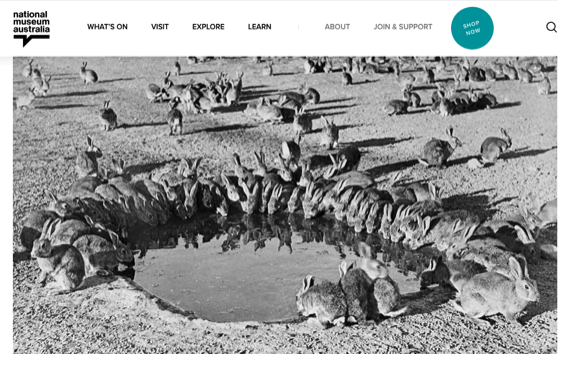
By constant repetition of the word ‘feral’ people no longer realise that the animals are sentient and are horses. As soon as the appellation ‘feral’ is applied people think that any amount of cruelty is justifiable.
It also implies that the animal is wild, uncontrolled and not OWNED by humans.
FAST FORWARD TO 36:18
The 36 minute 18 second mark of the 4 Corners program above is a perfect example of 2 things:
The denigration of a certain culture that people hold dear, and the gendered aspect of this debate.
Charles Massey is making a cultural comment as well as a comment that refers obliquely to qualities that women espouse.
He appears to be reflecting on the empathy that people feel for horses that are dying inhumanely.
Throughout history women have long been held to possess empathy and it has been derided.
Men are increasingly realising that they are allowed to experience feelings natural to all humans.
CULTURE WARS
Recently Richard Swain was quoted and he derides white culture explicitly by claiming that supporters of Brumbies have read the book ‘Silver Brumby’ or watched the film ‘Man from Snowy River’.
This was particularly offensive to white people, and to be sure he can point to offensive attitudes and actions by white people but 2 wrongs don’t make a right. It also betrays a negative attitude to Reconciliation.
Richard Swain is dog whistling to all people who have certain beliefs about the place of white people in Australia.
This is not to say there is anything wrong with those attitudes but he turns them into an axis to get support for destruction of Brumbies in a coded way. To destroy Brumbies is to destroy one of the archetypes of white society.
DOG WHISTLE & CATCH PHRASES
In politics, a dog whistle is the use of coded or suggestive language in political messaging to garner support from a particular group without provoking opposition. See: https://en.wikipedia.org/wiki/Dog_whistle_(politics)
The 4 Corners episode and the language of the proponents of wild horse destruction is full of coded language. As previously mentioned the word ‘feral’ is one such term that is imbued with meaning and is a loaded term which so self-respecting journalist would use.
By using ‘Brumby’ in the title, he thinks it gives him permission to disperse ‘feral horse’ throughout the segment.
And again, the use of the word Brumby also indicates a position.
The use of the catch-phrase ‘horse paddock’ is also a way of denigrating the role of the National Park and the people who seek to preserve the wild horses.
TROUT
Trout are not native and destroy the galaxia – a small native fish. AFAIK they still release trout into streams for fisherman. Trout are not native, they are an introduced species.
It is ironic that someone that loves trout fishing is interviewed for a show that wants to promote the protection of native animals and destroy introduced species.
There is a segment in the 4 Corners episode above where it is stated that the horse population has increased by 40% in the last 2 years. Such diatribes are completely contradicted by equine scientists who say that wild horses only increase by 8-10% per annum in the KNP.
It appears that people are correct when they claim that the wild horses are just being scapegoated. If people were genuine in wanting to save native animals, why is introducing non native trout that destroy a native fish okay?
[See the 7 minute 31 second mark of the 4 Corners video above.]
SPIN
Those advocating for the continued inhumane massacring of wild horses in the Kosciuszko National Park (KNP) have been very successful in driving a long campaign to eradicate the wild horses of the KNP.
Some of the critical aspects of their action campaign can be summarised as follows:
- Social media has been critical in building support
- It is important to have a political background that gives political understanding and a network of people with access to politicians and the media.
- Crucially it is important to make sure politicians see an alignment and political advantage in pursuing an issue
- Make sure that ‘scientific’ data backs up the extreme numbers narrative
- It is important to frame the narrative and stick to it
- Finally, have catchphrases and appellations such as ‘horse paddock’ and ‘feral’ to drive the narrative and provide people with a shorthand for communicating ideas
41 HORSES SHOT
SHOOTER SENTENCEDMount Isa man Christopher John Anderson, 50, has been sentenced to three and a half years' prison, wholly suspended, and ordered to pay $9,500 compensation after pleading guilty to one count of serious animal cruelty and several weapons and unlawful...
DOGGERS
AN OPEN LETTER TO THOSE DEFENDING DOGGERSThis is directed at those who defend "doggers". But first, there may be those who don't know what a dogger is. In Australia, a person who collects, buys or is given horses and takes them to slaughter is known as a dogger....

